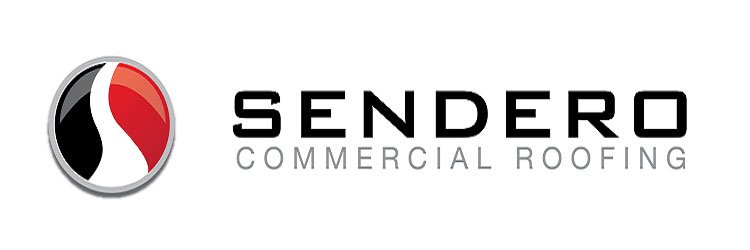About Sendero Commercial Roof Types

LOW SLOPE ROOF TYPES
The term low slope roofing is often synonymous with commercial roofing because of the typical flat roof designs. Several options exist for low slope roofing:
EPDM Thermoset Membrane
EPDM, ethylene propylene diene monomer, is a single-ply thermoset membrane that consists of a synthetic rubber compound that imparts flexibility and allows it to withstand the damaging effects of weather fluctuations, ultraviolet rays, ozone and chemicals. EPDM has been used in commercial roofing applications since the 1960s and is considered a reliable, time-tested option. EPDM thermoset membranes are ideal for large roof areas because their manufacturing size is intended to reduce the number of seams. The pieces are bonded together at the seams using liquid adhesives or specially formulated tape. EPDM roof membranes can be installed fully adhered, mechanically attached or ballasted.
PVC Thermoplastic Membrane
PVC, polyvinyl chloride, is a versatile single ply thermoplastic membrane with excellent flexibility, as well as increased resistance to UV, ozone, chemicals, tears, impact, and punctures. PVC is flame-retardant and won’t weaken through exposure to chemicals, oils, or grease. PVC membranes feature heat-welded seams to form a continuous membrane and can be installed fully adhered, mechanically attached or ballasted.
TPO Thermoplastic Membrane
TPO, thermoplastic polyolefin, is a single-ply membrane and has become a popular commercial roofing system over the past 20 years. TPO sheets are manufactured in a variety of colors and contain flame retardants, UV absorbers, colorants, and are reinforced with polyester. The seams are heat welded to form a strong bond and resist leaking. White and light-colored thermoplastic roof membranes offer solar reflectivity, which reduces cooling costs. TPO roof membranes can be installed fully adhered, mechanically attached or ballasted.
Metal panel roof systems for low-slope applications
Metal is a durable, lightweight and energy-efficient roofing material that is often used for commercial, institutional, and industrial structures. Structural metal panel roof systems can be used for low slope roofs because they are manufactured to be hydrostatic, or watertight at laps and other joints. The seam design and factory-applied sealant prevent air and water infiltration, and the height of the seams adds strength to withstand wind uplift. Most structural metal panels are used over spaced structural supports without being supported by a solid roof deck. Adequate ventilation is a consideration because the metal may be exposed to moisture if there is no deck or underlayment.
Built-Up Roof (BUR)
Built-up roofing or BUR systems are commonly referred to as “tar and gravel” roofs and have been widely used in the U.S. for more than 100 years. BUR systems are composed of alternating layers of bitumen and reinforcing fabrics, called roofing felts or ply sheets. A four-ply roof would have four layers in the finished membrane construction. The bitumen can be asphalt, coal tar or cold-applied adhesive. The heated asphalt or coal tar is applied by mop or mechanical spreader before a surfacing material is added. Some surfacings include gravel, mineral granules, glass-fiber or mineral surfaced cap sheets, aluminum coatings or elastomeric coatings.
Modified Bitumen
Modified bitumen, was introduced in 1978 and blended synthetic rubberized polymers with asphalt. Modified bitumen is available in smooth surfaced or granulated rolls that can be hot applied, cold applied or heat welded to the roof. Modified bitumen offers increased resistance to brittleness at cold temperatures, better flow resistance at high temperatures, more elasticity, and is easier to apply than tar and gravel. Modified bitumen membranes are manufactured with two formulas: Atactic Polypropylene (APP) and Styrene Butadiene Styrene (SBS).
STEEP SLOPE
Most single-family homes in the U.S. are constructed with some pitch or slope to the roof. Steep slope roofing products are critical aesthetic components for residential construction where the roof can consist of nearly half of the exterior appearance of a home.
Metal Roof Systems for Steep-Slope Applications
Once used primarily on commercial projects, metal roofs are increasingly common for residential projects. Metal roofs are durable and will stand up to heat and hurricane force winds. Metal roofing is also 100% recyclable. A steep slope metal roof has two categories:
Structural – A structural metal roof is most often installed over open framing but can be also be applied to a solid deck. These metal roofing systems come in a variety of styles including vertical standing seams, corrugated and tile profiles.
Architectural – A steel architectural roof differs from the structural systems in that they require a solid substrate of concrete, plywood or metal roof deck for application. The varieties for architectural metal roofs are standing seam, horizontal metal panels and, corrugated and tile profiles.
Asphalt shingles
Perhaps the most commonly used residential roofing system in North America is the asphalt shingle. Homeowners favor its relatively low upfront cost and ease of installation. Asphalt shingles are composed of a base material, asphalt and fillers, and a protective surfacing material, such as mineral granules. All asphalt shingles contain adhesive that is activated by the sun’s heat which seals each shingle to the next and provides resistance to wind uplift. Different types of residential asphalt shingles are available:
3-tab shingles are the most commonly selected, economical choice for homeowners and are available in an array of colors.
Architectural style also known as laminated or dimensional shingles provide a 3-dimensional look, imitating the look of natural wood or slate shingles. The shingle is constructed of two or more basic shingles laminated together.
Synthetic
Synthetic roofing materials are manufactured products that replicate the natural look and variations of slate, clay tile, wood shakes or wood shingles. Advanced manufacturing technologies and materials have given synthetic products a realistic appearance as well as resistance to weathering and durability. Synthetic roofs are made from a range of materials including polymers, recycled plastic and rubber. Fillers and modifiers can include mineral dust or cellulose fibers. Compared to their traditional counterparts, synthetic roofs can cost substantially less in both materials and labor. Many synthetic roofing products are certified for impact and fire resistance.
